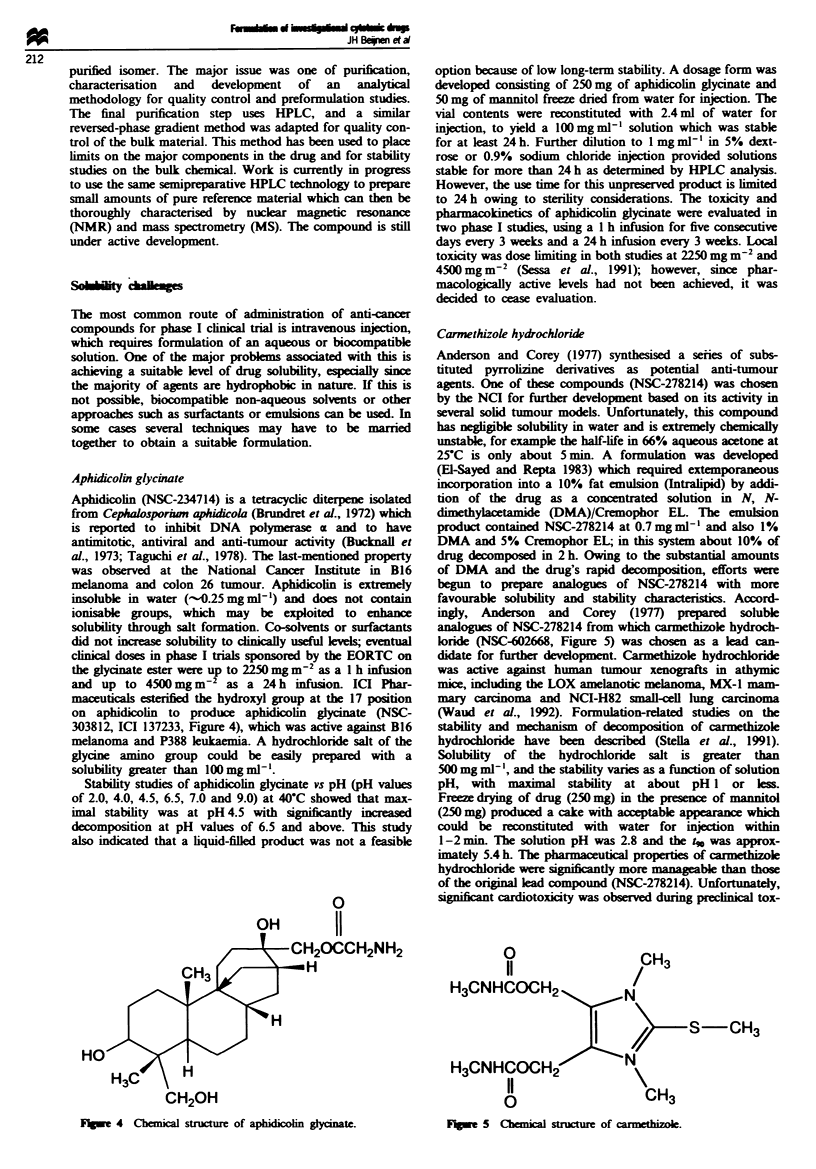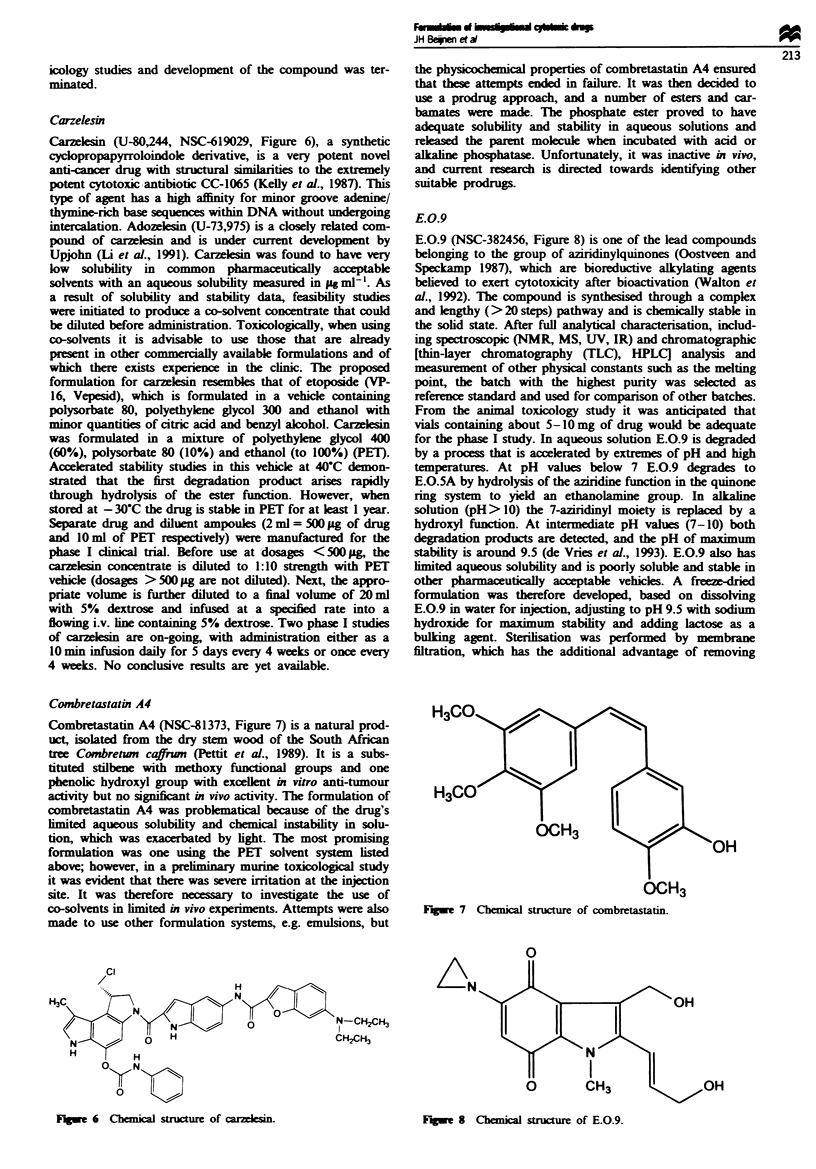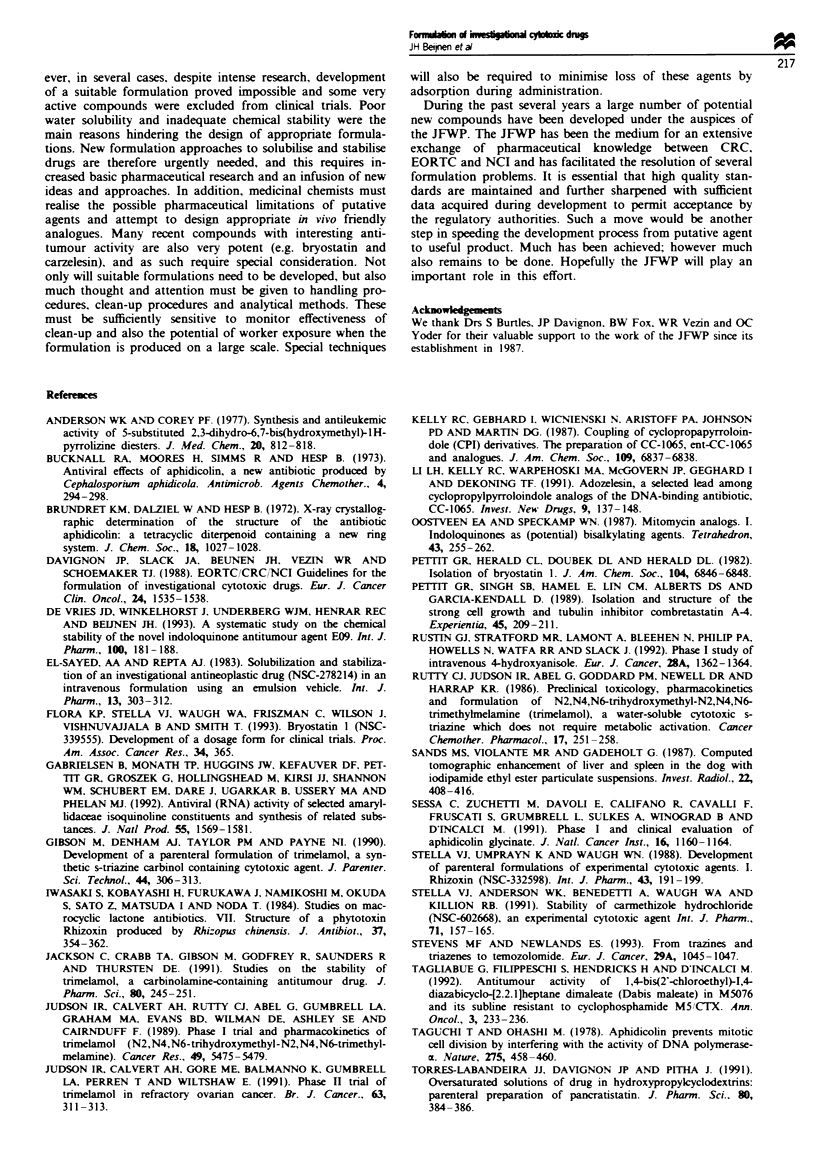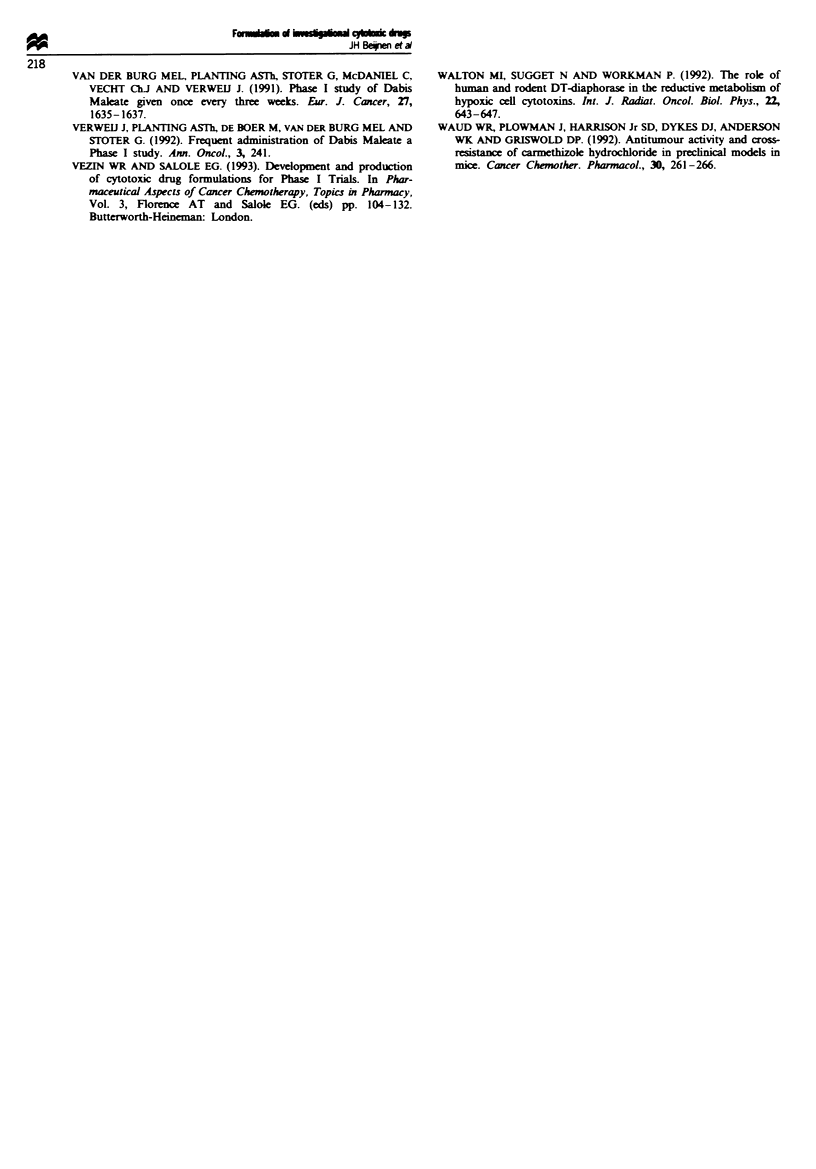Abstract
The pharmaceutical formulation of a new anti-tumour agent has often been perceived as the bottleneck in anti-cancer drug development. In order to increase the speed of this essential development step, the Cancer Research Campaign (CRC), the European Organization for Research and Treatment of Cancer (EORTC) and the National Cancer Institute (NCI) agreed in 1987 to form the Joint Formulation Working Party (JFWP). The main goal of the JFWP is to facilitate the rapid progress of a new drug through pharmaceutical developmental to preclinical toxicology and subsequently to phase I clinical trial. Under the auspices of the JFWP around 50 new agents have been developed or are currently in development. In this report we present our formulation experiences since the establishment of the JFWP with a selected number of agents: aphidicolin glycinate, bryostatin 1, carmethizole, carzelesin, combretastatin A4, dabis maleate, disulphonated aluminium phthalocyanine, E.O.9, 4-hydroxyanisole, pancratistatin, rhizoxin, Springer pro-drug, SRI 62-834, temozolomide, trimelamol and V489. The approaches used and problems presented may be of general interest to scientists in related fields and those considering submitting agents for development.
Full text
PDF








Selected References
These references are in PubMed. This may not be the complete list of references from this article.
- Anderson W. K., Corey P. F. Synthesis and antileukemic activity of 5-substituted 2,3-dihydro-6,7-bis(hydroxymethyl)-1H-pyrrolizine diesters. J Med Chem. 1977 Jun;20(6):812–818. doi: 10.1021/jm00216a014. [DOI] [PubMed] [Google Scholar]
- Bucknall R. A., Moores H., Simms R., Hesp B. Antiviral effects of aphidicolin, a new antibiotic produced by Cephalosporium aphidicola. Antimicrob Agents Chemother. 1973 Sep;4(3):294–298. doi: 10.1128/aac.4.3.294. [DOI] [PMC free article] [PubMed] [Google Scholar]
- Davignon J. P., Slack J. A., Beijnen J. H., Vezin W. R., Schoemaker T. J. EORTC/CRC/NCI guidelines for the formulation of investigational cytotoxic drugs. Eur J Cancer Clin Oncol. 1988 Sep;24(9):1535–1538. doi: 10.1016/0277-5379(88)90349-5. [DOI] [PubMed] [Google Scholar]
- Gabrielsen B., Monath T. P., Huggins J. W., Kefauver D. F., Pettit G. R., Groszek G., Hollingshead M., Kirsi J. J., Shannon W. M., Schubert E. M. Antiviral (RNA) activity of selected Amaryllidaceae isoquinoline constituents and synthesis of related substances. J Nat Prod. 1992 Nov;55(11):1569–1581. doi: 10.1021/np50089a003. [DOI] [PubMed] [Google Scholar]
- Gibson M., Denham A. J., Taylor P. M., Payne N. I. Development of a parenteral formulation of trimelamol, a synthetic S-triazine carbinolamine-containing cytotoxic agent. J Parenter Sci Technol. 1990 Nov-Dec;44(6):306–313. [PubMed] [Google Scholar]
- Ikegami S., Taguchi T., Ohashi M., Oguro M., Nagano H., Mano Y. Aphidicolin prevents mitotic cell division by interfering with the activity of DNA polymerase-alpha. Nature. 1978 Oct 5;275(5679):458–460. doi: 10.1038/275458a0. [DOI] [PubMed] [Google Scholar]
- Iwasaki S., Kobayashi H., Furukawa J., Namikoshi M., Okuda S., Sato Z., Matsuda I., Noda T. Studies on macrocyclic lactone antibiotics. VII. Structure of a phytotoxin "rhizoxin" produced by Rhizopus chinensis. J Antibiot (Tokyo) 1984 Apr;37(4):354–362. doi: 10.7164/antibiotics.37.354. [DOI] [PubMed] [Google Scholar]
- Jackson C., Crabb T. A., Gibson M., Godfrey R., Saunders R., Thurston D. E. Studies on the stability of trimelamol, a carbinolamine-containing antitumor drug. J Pharm Sci. 1991 Mar;80(3):245–251. doi: 10.1002/jps.2600800311. [DOI] [PubMed] [Google Scholar]
- Judson I. R., Calvert A. H., Gore M. E., Balmanno K., Gumbrell L. A., Perren T., Wiltshaw E. Phase II trial of trimelamol in refractory ovarian cancer. Br J Cancer. 1991 Feb;63(2):311–313. doi: 10.1038/bjc.1991.72. [DOI] [PMC free article] [PubMed] [Google Scholar]
- Judson I. R., Calvert A. H., Rutty C. J., Abel G., Gumbrell L. A., Graham M. A., Evans B. D., Wilman D. E., Ashley S. E., Cairnduff F. Phase I trial and pharmacokinetics of trimelamol (N2,N4,N6-trihydroxymethyl-N2,N4,N6-trimethylmelamine). Cancer Res. 1989 Oct 1;49(19):5475–5479. [PubMed] [Google Scholar]
- Li L. H., Kelly R. C., Warpehoski M. A., McGovren J. P., Gebhard I., DeKoning T. F. Adozelesin, a selected lead among cyclopropylpyrroloindole analogs of the DNA-binding antibiotic, CC-1065. Invest New Drugs. 1991 May;9(2):137–148. doi: 10.1007/BF00175081. [DOI] [PubMed] [Google Scholar]
- Pettit G. R., Singh S. B., Hamel E., Lin C. M., Alberts D. S., Garcia-Kendall D. Isolation and structure of the strong cell growth and tubulin inhibitor combretastatin A-4. Experientia. 1989 Feb 15;45(2):209–211. doi: 10.1007/BF01954881. [DOI] [PubMed] [Google Scholar]
- Rustin G. J., Stratford M. R., Lamont A., Bleehen N., Philip P. A., Howells N., Watfa R. R., Slack J. A. Phase I study of intravenous 4-hydroxyanisole. Eur J Cancer. 1992;28A(8-9):1362–1364. doi: 10.1016/0959-8049(92)90520-c. [DOI] [PubMed] [Google Scholar]
- Rutty C. J., Judson I. R., Abel G., Goddard P. M., Newell D. R., Harrap K. R. Preclinical toxicology, pharmacokinetics and formulation of N2,N4,N6-trihydroxymethyl-N2,N4,N6-trimethylmelamine (trimelamol), a water-soluble cytotoxic s-triazine which does not require metabolic activation. Cancer Chemother Pharmacol. 1986;17(3):251–258. doi: 10.1007/BF00256694. [DOI] [PubMed] [Google Scholar]
- Sands M. S., Violante M. R., Gadeholt G. Computed tomographic enhancement of liver and spleen in the dog with iodipamide ethyl ester particulate suspensions. Invest Radiol. 1987 May;22(5):408–416. doi: 10.1097/00004424-198705000-00009. [DOI] [PubMed] [Google Scholar]
- Sessa C., Zucchetti M., Davoli E., Califano R., Cavalli F., Frustaci S., Gumbrell L., Sulkes A., Winograd B., D'Incalci M. Phase I and clinical pharmacological evaluation of aphidicolin glycinate. J Natl Cancer Inst. 1991 Aug 21;83(16):1160–1164. doi: 10.1093/jnci/83.16.1160. [DOI] [PubMed] [Google Scholar]
- Stevens M. F., Newlands E. S. From triazines and triazenes to temozolomide. Eur J Cancer. 1993;29A(7):1045–1047. doi: 10.1016/s0959-8049(05)80221-7. [DOI] [PubMed] [Google Scholar]
- Tagliabue G., Filippeschi S., Hendricks H., D'Incalci M. Antitumor activity of 1,4-bis (2'-chloroethyl)-1,4-diazabicyclo-[2.2.1] heptane dimaleate (Dabis Maleate) in M5076 and its subline resistant to cyclophosphamide M5/CTX. Ann Oncol. 1992 Mar;3(3):233–236. doi: 10.1093/oxfordjournals.annonc.a058158. [DOI] [PubMed] [Google Scholar]
- Torres-Labandeira J. J., Davignon P., Pitha J. Oversaturated solutions of drug in hydroxypropylcyclodextrins: parenteral preparation of pancratistatin. J Pharm Sci. 1991 Apr;80(4):384–386. doi: 10.1002/jps.2600800421. [DOI] [PubMed] [Google Scholar]
- Verweij J., Planting A. S., de Boer M., van der Burg M. E., Stoter G. Frequent administration of Dabis Maleate, a phase I study. Ann Oncol. 1992 Mar;3(3):241–242. doi: 10.1093/oxfordjournals.annonc.a058161. [DOI] [PubMed] [Google Scholar]
- Walton M. I., Sugget N., Workman P. The role of human and rodent DT-diaphorase in the reductive metabolism of hypoxic cell cytotoxins. Int J Radiat Oncol Biol Phys. 1992;22(4):643–647. doi: 10.1016/0360-3016(92)90495-4. [DOI] [PubMed] [Google Scholar]
- Waud W. R., Plowman J., Harrison S. D., Jr, Dykes D. J., Anderson W. K., Griswold D. P., Jr Antitumor activity and cross-resistance of carmethizole hydrochloride in preclinical models in mice. Cancer Chemother Pharmacol. 1992;30(4):261–266. doi: 10.1007/BF00686292. [DOI] [PubMed] [Google Scholar]
- van der Burg M. E., Planting A. S., Stoter G., McDaniel C., Vecht C. J., Verweij J. Phase I study of DABIS maleate given once every 3 weeks. Eur J Cancer. 1991;27(12):1635–1637. doi: 10.1016/0277-5379(91)90433-e. [DOI] [PubMed] [Google Scholar]


